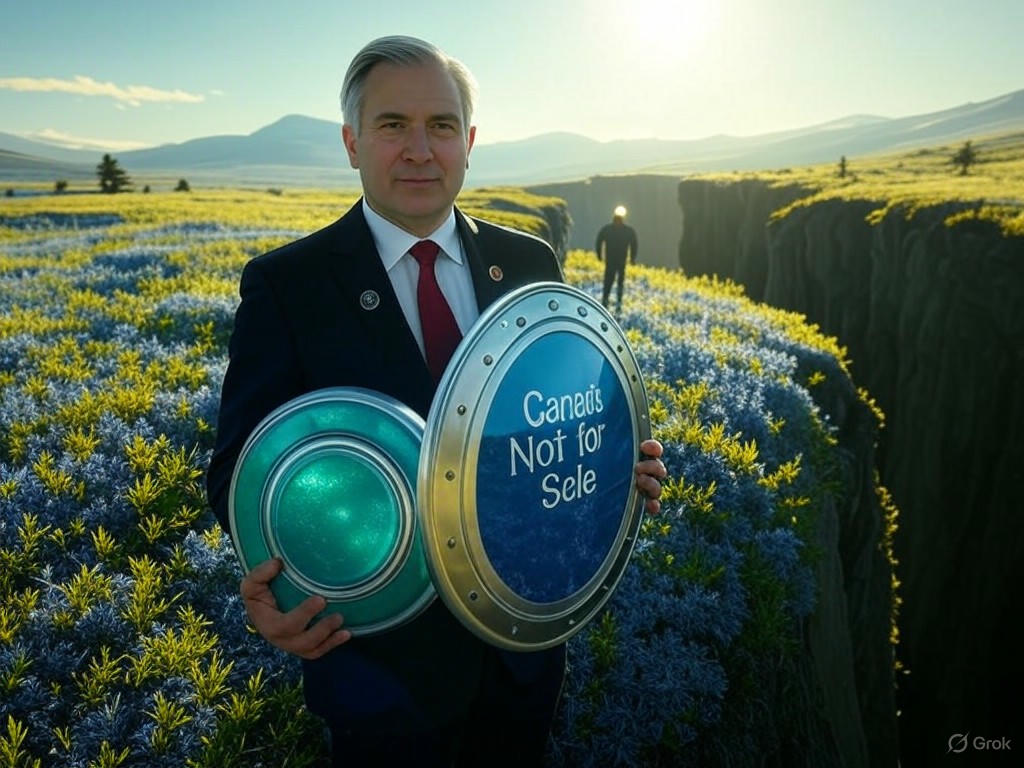
Canada Not for Sale: Carney Warns Trump Post-Meeting
The Landmark Washington Meeting and ‘Canada Not for Sale’
On May 6, 2025, Canadian Prime Minister Mark Carney and U.S. President Donald Trump convened in the White House for their first high-stakes summit since Carney’s election win. This gathering quickly became a flashpoint, with Carney’s bold declaration that Canada not for sale echoing far beyond the Oval Office. It was a direct rebuttal to Trump’s provocative hints about Canada joining as America’s 51st state, underscoring deeper issues in trade and national sovereignty that affect everyday people on both sides of the border.
Have you ever stopped to think how a single conversation between leaders can ripple into global headlines? In this case, it highlighted the fragile balance of power in North American relations, making Canada not for sale a rallying cry for independence amid ongoing economic pressures.
How Tensions Built Up to This ‘Canada Not for Sale’ Moment
The stage for this summit was set by weeks of escalating diplomatic sparring. Trump’s offhand comments about absorbing Canada, coupled with persistent tariff disputes, had already stirred unease among Canadians and Americans alike. Carney, fresh from his campaign, positioned himself as a guardian of national interests, turning Canada not for sale into a powerful election slogan that galvanized voters.
Picture this: just like a hockey game where defenses tighten before a big play, Carney’s approach was strategic and defensive. He drew on historical precedents, such as past trade wars, to emphasize why Canada not for sale isn’t just rhetoric—it’s a commitment to protecting jobs in industries like automotive and agriculture. A study from Politico found that these tensions boosted Carney’s approval ratings, showing how public sentiment can sway international dynamics.
Carney’s Defiant Stand: Echoing ‘Canada Not for Sale’
During the Oval Office talks, Trump revisited his idea of Canada as a “51st state,” even dangling U.S. tax breaks as bait. But Carney didn’t flinch. With a composed yet firm demeanor, he responded, “There are some places that are never for sale. We’re sitting in one right now… Having met with the owners of Canada, it’s not for sale, it won’t be for sale, ever.” This moment crystallized the Canada not for sale ethos on a world stage.
The Deeper Meaning Behind Carney’s ‘Canada Not for Sale’ Declaration
This wasn’t mere political posturing; it was a profound statement of national integrity. By likening Canada to untouchable symbols like Buckingham Palace, Carney reinforced that sovereignty is non-negotiable. In a world where borders feel increasingly fluid, this stance serves as a reminder for smaller nations to assert their rights. If you’re following global politics, you might ask: How can individuals support such principles? Start by staying informed and advocating for fair policies in your community.
For instance, imagine if your hometown faced a similar threat—wouldn’t you want leaders to draw a line? Carney’s words inspired a wave of national pride, turning Canada not for sale into a movement that could influence future negotiations.
Trump’s Vision: Real Estate Angles Versus ‘Canada Not for Sale’
As a self-proclaimed dealmaker, Trump used familiar real estate metaphors to pitch his ideas. He mused about erasing borders, saying, “When you get rid of that artificially drawn line… that’s the way it was meant to be.” Yet, despite this artistic flair, his remarks clashed directly with the Canada not for sale narrative.
Trump’s “never say never” attitude hinted at potential integrations, but it didn’t address the real pain points, like tariffs on Canadian steel and aluminum. This approach raises questions: Is this just negotiation tactics, or a genuine push for expansion? Either way, it highlighted the contrast with Carney’s steadfast position, making Canada not for sale a key counterpoint in the discussion.
Key Disputes: Tariffs and the ‘Canada Not for Sale’ Resolve
At the heart of the meeting were unresolved issues like U.S. tariffs on Canadian goods, which continue to strain economies. Carney vowed to “fight” for relief, while Trump showed no signs of backing down, creating a deadlock that embodies the Canada not for sale spirit.
Public Backlash and the ‘Elbows Up’ Echo of ‘Canada Not for Sale’
Back in Canada, Carney’s toughness resonated deeply. His “Elbows up!” phrase, inspired by hockey icon Gordie Howe, became a symbol of resilience against U.S. pressures. It’s a relatable analogy—if you’ve ever cheered for an underdog team, you know that grit can turn the tide. This public reaction further solidified Canada not for sale as more than words; it’s a cultural stance encouraging citizens to engage in advocacy.
Navigating Media Spin Around ‘Canada Not for Sale’
Social media exploded after the summit, with misattributed quotes and viral clips muddying the waters. Fact-checkers, like those from AFP, quickly clarified that some criticisms weren’t Carney’s, keeping the focus on his genuine defense of Canada not for sale. In an era of misinformation, this underscores the importance of verifying sources before forming opinions.
Think about it: How often do online rumors shape your view of international events? By sticking to verified reports, we can better appreciate Carney’s measured approach to maintaining strong, independent ties with the U.S.
Contrasting Styles: Carney’s ‘Canada Not for Sale’ Versus Trump’s Ambitions
| Mark Carney | Donald Trump |
|---|---|
| Reaffirms Canada not for sale sovereignty | Proposes provocative expansion ideas |
| Pushes for fair trade and tariff relief | Defends tariffs while offering tax incentives |
| Uses rallying cries like “Elbows up!” | Employs deal-making metaphors |
| Emphasizes boundaries in partnerships | Frames unity as potential real estate wins |
This comparison illustrates how Carney’s Canada not for sale philosophy stands in stark contrast to Trump’s bolder tactics, offering a blueprint for diplomatic engagement.
Future Outlook: Sustaining ‘Canada Not for Sale’ in Relations
Looking ahead, both leaders expressed interest in revitalizing trade, but the tariff stalemate looms large. Experts predict that Carney’s Canada not for sale stance will define negotiations, potentially leading to innovative solutions like joint economic forums. For readers interested in global affairs, this is a prime opportunity to learn from history—perhaps by exploring past agreements like NAFTA and how they evolved.
What strategies could help? Governments might prioritize transparent talks, while citizens can push for policies that protect local industries, ensuring Canada not for sale remains a guiding principle.
Wrapping Up: The Lasting Impact of ‘Canada Not for Sale’
Prime Minister Carney’s assertion that Canada not for sale has left a lasting mark, uniting people around themes of self-determination and resilience. As these two nations navigate their shared future, it’s a timely reminder that sovereignty isn’t just about borders—it’s about preserving what’s uniquely ours. If this topic sparks your curiosity, consider diving into related stories on international diplomacy.
We’d love to hear from you: What do you think about this standoff, and how does it reflect broader global trends? Share your insights in the comments, or check out our other posts on U.S.-Canada dynamics for more context.
References
- Politico: Carney says Canada ‘not for sale’ while Trump pitches tax breaks
- CBS News: Watch Mark Carney tell Trump Canada will not be 51st state
- YouTube: Key moments from the Carney-Trump meeting
- AFP Fact Check: Quote attacking Trump falsely attributed to Mark Carney
- White House Economic Report
- Practice of Public Relations
- OAPEN: International Relations Study
- Sociologie Journal: Borders and Sovereignty






